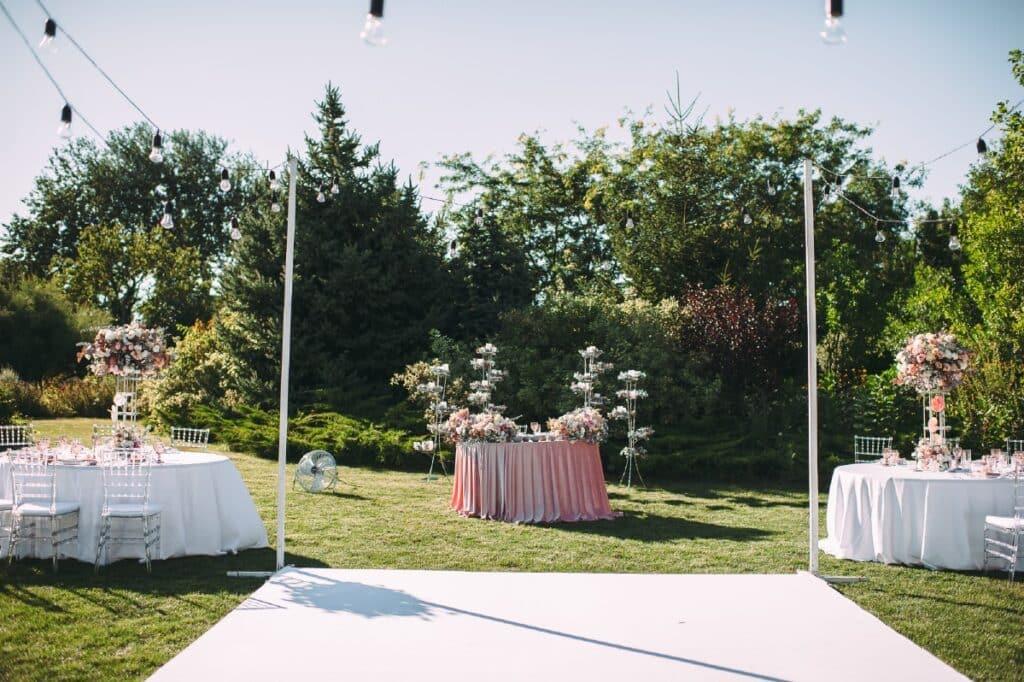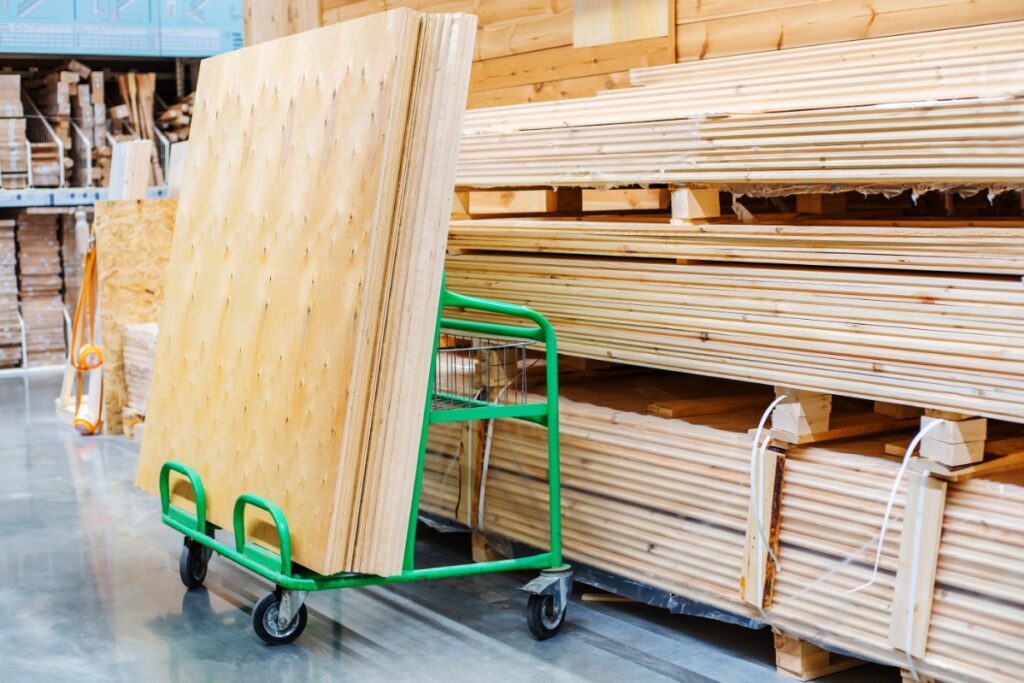Installing an outdoor dancefloor on uneven ground can be a challenging task. However, with the right tools and materials, it’s possible to create a level surface that will be both safe and functional.
Build Outdoor Dancefloor on Uneven Ground
This step-by-step guide will show you how to install an outdoor dancefloor on uneven ground.
You are watching: How To Install an Outdoor Dance Floor on Uneven Ground (2023 Guide)
Step 1: Determine the Size of the Dancefloor

The first step in building an outdoor dancefloor is to determine the size of the surface. This will depend on the number of people using the space and the type of dancing that will be taking place. Once you have determined the size, mark out the area with stakes and string.
During this stage, you also determine the shape of your dancefloor. The most common shapes are square or rectangular, but you can create a more custom shape if desired.
Step Two: Level the Ground
The next step is to level the ground. You can do this by using a shovel to remove any high spots and fill in any low areas. Once the ground is level, compact it with a tamper.
When building on uneven ground, this step is crucial. The dancefloor could become unstable and unsafe if the ground is not level.
Again, you may not want to dig around the lawn too much. If you have to remove more than a few inches of dirt, it might be best to level the dancefloor using other materials such as plywood or pavers.
Step Three: Lay the Dancefloor
The next step is to lay the dancefloor. This step depends on the materials to be used for the surface.
Plywood

A plywood subfloor is a good option for an outdoor dancefloor. You should use pressure-treated plywood to withstand the elements. You’ll also need to seal the plywood to protect it from moisture.
To install the plywood, you need to screw it into the ground using deck screws. Be sure to pre-drill the holes to avoid splitting the wood.
A framed plywood subfloor is also an option. This will provide additional support and stability for the dancefloor.
Pavers
Another option for an outdoor dancefloor is pavers. Pavers are a good choice because they are durable and easy to install. Pavers are also non-slip, which is essential for safety.
To install pavers, dig a trench around the perimeter of the dancefloor. The trench should be about six inches deep and wide enough to accommodate the pavers.
Read more : Outdoor Wood Paint Ideas For Exterior Surfaces
Once the trench is dug, fill it with gravel and compact it. Next, lay the pavers in the trench and fill the gaps with sand.
Dancefloor Tiles
Dancefloor tiles are another option for an outdoor dancefloor. Tiles are easy to install and come in various colors and styles. They are also non-slip, which is vital for safety.
To install dancefloor tiles, first prepare the surface. You can do this by leveling the ground and compacting it. Next, lay a layer of gravel over the surface.
Some tiles are designed to interlock, while others will need to be glued down. Be sure to follow the manufacturer’s instructions for installation.
Carpet
You can also use carpet to create an outdoor dancefloor. Carpet is easy to install and comes in various colors and styles.
Be sure to choose a carpet that’s designed for outdoor use. Also, remember leveling the ground and compacting are still necessary when using carpet.
Next lay a layer of gravel over the surface. Then, unroll the carpet and cut it to size. Be sure to leave enough excess around the perimeter so that you can staple or glue it down.
When choosing a carpet, you must consider what type of shoes your guests will wear. For example, if they’ll be wearing high heels, select a thicker carpet to avoid damaging the floor. On the other hand, some people may prefer barefoot dancing, so you’ll need to consider carpet texture and comfort.
Raised Stage Platforms
To create a raised stage area, you’ll need to build platforms. You can make platforms from various materials such as plywood, metal scaffolding, or interlocking deck tiles.
To build a platform, determine the stage’s size and shape. Then, cut the materials to size and assemble them using screws or bolts. Finally, make the platform sturdy and stable before adding any weight to it.
It’s important to consider accessibility when building a raised stage. So, make sure a ramp or staircase leads up to the stage so everyone can enjoy the performance.
Step Four: Install the Bordering
A dancefloor without clearly defined edges can be dangerous. Therefore, it’s important to install a border around the perimeter of the dancefloor to keep dancers safe.
There are a few different options for bordering an outdoor dancefloor. Pavers can be used to create a low border that will not trip dancers.
Another option is to use rope or tape to create a physical boundary. This is a good option if you do not want to damage the lawn.
Step Five: Test the Floor
Read more : How Long Does Patio Furniture Last?
Before your guests arrive, it’s a good idea to test the floor to ensure it’s level, safe, and sturdy. Dance around on the floor to ensure no loose tiles or carpet edges. Also, check the bordering to ensure it’s secure and make any necessary adjustments.
Frequently Asked Questions
Still have questions? Here are some answers to common queries regarding building dancefloors.
Can you put a dancefloor on the grass?
Yes, you can put a dancefloor on the grass. However, it’s essential to ensure the ground is level and compacted. You’ll also need thicker plywood or carpet to avoid damaging the grass.
Several options, such as portable framed plywood subfloors, raised stage platforms, or even a layer of interlocking tiles over grass, are available to create a level surface.
How do you make an outdoor dancefloor non-slip?
There are several ways to make an outdoor dancefloor non-slip. One option is to use naturally slip-resistant pavers.
Another option is to use tiles or carpets designed for outdoor use. You can also add a layer of sand to the surface to increase traction.
Can you make a dancefloor out of pallets?
Yes, you can make a dancefloor out of pallets. Pallets are a cheap and easy way to create a sturdy surface. However, it’s vital to ensure the pallets are clean and in good condition before using them.
To make a pallet dancefloor, level and compact the ground. Then, lay a layer of gravel over the surface. Next, arrange the pallets on top of the gravel.
Since pallets have spaces between the slats, you may want to use plywood or carpet to create a smooth surface. Finally, border the dancefloor with pavers or rope.
Pallets can also make great framed subflooring for a portable dancefloor. Simply screw the pallets together and cover them with plywood or carpet.
How do you make a dancefloor without damaging the lawn?
If you do not want to damage the lawn, you can use a layer of interlocking tiles or a portable subfloor. Another option is to build a raised stage platform. These are options that do not require excavation or grass removal.
Conclusion
Your outdoor events do not have to be limited by uneven ground. Following these simple steps, you can install a dancefloor on any surface.
Be sure to take the time to test the floor and make any necessary adjustments before your event. With some planning, you can create a safe and fun environment for your guests.
Source: https://gardencourte.com
Categories: Outdoor


